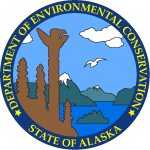| Action Date |
Action |
Description |
DEC Staff |
| 10/11/1991 |
Update or Other Action |
Harding Lawson report
Site G: Building 47811. Veterinary Clinic
UST 72, a 775-gal10n tank previously containing diesel (heating oil), was removed from the west side of Building 47811 (Plate 9). The final excavation was approximately 22 feet deep and measured 54 feet by 36 feet at the surface. The volume of soil removed during tank excavation was approximately 531 cubic yards. A replacement tank was not installedSamples from excavation limits showed diesel range organics (DRO) up to 8,900 mg/kg. |
Louis Howard |
| 9/2/1993 |
Update or Other Action |
Preliminary Release Investigation Report Underground Storage Tank Sites Fort Richardson, Alaska, dated July 6, 1993 received by ADEC for review and comment. The report covers the following sites:
Plate 3 Site A, Building 45590, Old Auto Hobby Shop
Plate 4 Site B, Building 750, Motor Pool
Plate 5 Site C, Building 755, Auto and Crafts Center
Plate 6 Site D, Building 756, Motor Pool
Plate 7 Site E, Building 974, Special Purpose Equipment Repair Shop
Plate 8 Site F, Building 796, Vehicle and Weapons Repair Shop
Plate 9 Site G, Building 47811, Veterinary Clinic
Plate 10 Site H, Building 47438, Bryant Anny Airfield Fuel Facility
Plate 11 Site I, Building 47641, Former Aero Club
Plate 12 Site J, Buildi ng 28004, Chlorination Facility
Plate 13 Site K, Building 955, Used POL Holding Facility |
John Halverson |
| 9/21/1993 |
Update or Other Action |
A.G. letter (Breck Tostevin) to Tamela J. Tobia, OS Judge Advocate for the Army. Letter states that a separate petroleum site compliance agreement should be separate from the CERCLA federal facility agreement. The petroleum site restoration agreement would function as a "two-party agreement" under the FFA. It would track the basic provisions of the UST Agreement but be tailored to the State's contaminated site regulations and would interface with the FFA. All petroleum sites addressed under the Two Party agreement would be reviewed in the final operable unit of the FFA and actions taken would be memorialized in a Record of Decision (ROD) under the FFA. |
Louis Howard |
| 3/18/1994 |
Update or Other Action |
Release investigation "Release Investigation Report Underground Storage Tank Sites Fort Richardson Alaska" was performed by Harding Lawson Associates in 1993. Diesel range organics (DRO) were found in boring AP-3242 bgs: 10' ND, 15 8.8 mg/kg, 20' 474 mg/kg, 25' 2,450 mg/kg, 30' 1,220 mg/kg, 35' 918 mg/kg, 40' 73-86 mg/kg, 45' 221 mg/kg, and 50' 240 mg/kg.
AP-3177 had DRO bgs: 10' 11,000 mg/kg and 15' 551 mg/kg.
Cleanup level matrix level is "B" 100 mg/kg GRO, 200 mg/kg DRO, 2,000 mg/kg RRO, 0.5 mg/kg benzene, and total BTEX of 15 mg/kg. |
Louis Howard |
| 10/24/1994 |
Document, Report, or Work plan Review - other |
Letter to USARK APVR-RPW-EV RE: Bldg. 47811 Bioventing Conceptual Design contract# DACA 85-94-D-0014
The Alaska Department of Environmental Conservation-Defense Facilities Oversight group
(ADEC) has received, on October 24, 1994 the above referenced document. Below are ADEC's
comments. Page 2 refers to "subsurface soils at building 908 South?" Please correct text to refer to bldg. 47811 site.
3.0 Blower Design and BioventinglSVE Blower Installation Phase page 3 para. 3
To meet the requirements of the air quality program, please provide an estimate of the quantity
of volatile hydrocarbons emitted to the atmosphere from the blower being operated at full
capacity. With the exception of this minor detail, the design is approved as submitted. |
Louis Howard |
| 5/15/1995 |
Cleanup Plan Approved |
A bioventing evaluation was performed, and the results indicated that this site was a viable remedial alternative for the site. In March 1995 a soil vapor extraction (SVE) bioventing system was installed by Agra Earth and Evironmental. The bioventing system consisted of two independent arrays separated by an aquitard at approximately 22 feet below ground surface (bgs). The shallow system included 2 vapor extraction wells installed to approximately 22 ft. bgs.
The deeper system had 4 deep air injection wells installed to approximately 55 ft. bgs, and five passive wells installed to a depth of approximately 40 ft. bgs. Air was injected into the deeper wells and vented through the passive wells. The regenerative blowers for the two systems were housed in a common treatment shelter. |
Louis Howard |
| 1/31/1997 |
Update or Other Action |
During remediation in 1996 (biovent/SVE system installed in 1995) samples were taken by AGRA Earth and Environmental Inc. (Interim Remedial Action Report No. 2 for Soil Vapor Extraction System at Building 47-811 Fort Richardson, Alaska" to determine what, if any, progress was being made towards cleanup level "B" by the treatment system. Boring CB-3 bgs: 25' 1,900 mg/kg, 30' 880 mg/kg, 40' 12 mg/kg. Borgin CB-2 bgs: 25' 560 mg/kg, 35' 62 mg/kg. |
Louis Howard |
| 2/17/1997 |
Site Added to Database |
Contaminated soil. |
Louis Howard |
| 4/21/1998 |
Site Ranked Using the AHRM |
Ranking action added now because it was not added when the site was originally ranked. |
Bill Petrik |
| 4/22/1998 |
Update or Other Action |
After three years of bioventing confirmational sampling of soils showed that the level of contamination is not below DEC cleanup levels (200 mg/kg DRO category "B") for the site at depth (i.e. >20 ft. bgs). Letter of conditional closure sent to Army on 12/15/1998. |
Louis Howard |
| 7/2/1998 |
Institutional Control Record Established |
Updated USARAK institutional control policies and procedures received. The draft USARAK Command Policy Memorandum, ICs standard operating procedure and revised excavation clearance request have been finalized. To ensure the effectiveness of institutional controls, all organizational units and tenant activities will be informed on an annual basis of the institutional controls on contaminated soils and groundwater in effect on USARAK property. Where institutional controls are applicable to any organization, tenant, or activity, land use restrictions shall be incorporated into either a lease or Memorandum of Agreement, as appropriate. Costs for any and all remedial actions and fines and/or stipulated penalties levied as a result of a violation of an established institutional control shall be funded by the violating activity or organization. |
Louis Howard |
| 9/7/1998 |
Update or Other Action |
The purpose of the August 17 and 18, 1998 sampling event was to document the site contaminant levels after remedation by the bioventing/soil vapor extraction system. Two borings were drilled to about 50' bgs and soil samples for chemical testing were collected 10' bgs and at 5' intervals until boring completion. All were analyzed for GRO, DRO, RRO, BTEX, PAHs. No sample exceeded the category "B" cleanup levels of: 100 mg/kg for GRO, 2,000 mg/kg for RRO, 0.5 mg/kg for benzene, or the 15 mg/kg for total BTEX. Several samples exceeded the ADEC UST regulation cleanup level "B" limit of 200 mg/kg for DRO. Higheste DRO was 4,200 mg/kg.
AP-3926 was located near the southern limit of the tank excavation and AP-3927 was located within the former excavation limit. Boring AP-3926 bgs for DRO: 20' 120 mg/kg, 25' 4,200 mg/kg, 30' 1,500 mg/kg, 35' 1,300 mg/kg, 40' 330 mg/kg, 45' 18 mg/kg, and 50' 26 mg/kg. Boring AP-3927 DRO bgs: 10' 25 mg/kg, 15' 220 mg/kg, 20' 2,900 mg/kg, 25' 1,200 mg/kg, 30' 440 mg/kg, 35' 170 mg/kg, 40' 280 mg/kg, 45' 2,000 mg/kg, 50' 1,300 mg/kg (most are above Level "B" criteria for DRO:200 mg/kg).
DRO levels in AP-3927 are elevated from 15 to 30 ft. bgs, then increase again at 40 to 50 foot depth. Field observations are consistent with these data. It is not known why contamination is discontinuous in that area. |
Louis Howard |
| 12/15/1998 |
Update or Other Action |
Institutional controls on soil contamination left in place at depths greater than 15 feet. Soils excavated by any party at the site that are above Level "A" criteria will require treatment to be remediated to these levels. The following policy applies for soil regulated under 18 AAC 75 and 18 AAC 78 that is proposed for disposal off site from where it was generated. If the following criteria is met, ADEC approval and/or an institutional control(s) are not required:
1. The soil meets the most stringent Method Two, Migration to Groundwater, Table B2 cleanup level, and the most stringent standards for those chemicals under Table B1;
2. The soil may only be disposed of at any non-environmentally sensitive location in the Under 40" or Over 40" annual precipitation zone;
3. The soil is not placed within 100 feet of water wells, surface waters, and drainage ditches; and
4.The written approval from the landowner of the off-site location is required. The off site disposal of all other soil subject to the site cleanup rules that does not meet the criteria above shall be reviewed by the ADEC project manager in order to determine if the off-site disposal action poses a current or future risk to human health or the environment. The final approval to dispose of soil off site that does not meet the criteria shall be made by the ADEC Section Manager. |
Louis Howard |
| 6/2/2006 |
Update or Other Action |
Construction for a new working dog facility (FTR299) is currently underway in the area west of Bldg 47-811. Historical records indicate this was a former UST site that received closure from ADEC in 1998.
On 02 June 2006, the site workers stopped work and notified DPW Environmental that contamination had been encountered. A site visit and historical research support that the contamination is associated with the UST removal.
The site photographs show the approximate northern extent of the excavation where the contamination was found, as well as the sampling location. In addition to sampling, the Army plans to screen and stockpile contaminated soils on a short-term liner for characterization and disposal. |
Louis Howard |
| 6/7/2006 |
Update or Other Action |
ADEC has received information from the Army regarding discovery of contaminated soil encountered during excavation work for a new working dog facility (FTR299) currently underway in the area west of Bldg 47-811. ADEC has previously on December 15, 1998, officially closed out the site (LUST reckey no. 199721X004813 Event ID 489). Upon further review of the 1998 Post-Remedial Site Investigation, it was shown that a heating oil tank had leaked and residual contamination remains for diesel range organics above cleanup level B (200 mg/kg) at depths greater than 20 feet bgs. These depths were determined at the time to be beyond the reach of normal excavating equipment. Further, sloping the sides of the excavation at a one-to-one (45 degrees) ratio for safety and health considerations would have resulted in undermining both the site and the Davis Highway. For these reasons, alternatives involving excavation were not considered viable by the Army and ADEC.
ADEC has reviewed the site information and based on current report of contaminated soil being encountered at the site, it will be changing the site status for the site from officially closed to conditional closure. Residual soil contamination must be dealt with in accordance with Title 18, Chapter 75 of the Alaska Administrative Code, Oil and Other Hazardous Substances Pollution Control regulations (18 AAC 75, as amended through October 16, 2005). The Army had not placed this site in its GIS as an area of concern where contaminated soil remains in place above cleanup levels. ADEC requests the Army add this site to its GIS database with the required institutional controls and dig permit caveats required of sites with residual soil contamination above cleanup levels.
Additionally, excavated soil which is currently stockpiled and determined to be contaminated needs to be properly managed, transported, and treated in accordance with 18 AAC 75. |
Louis Howard |
| 6/7/2006 |
Update or Other Action |
File number reassigned to 2102.38.056 (formerly 2102.26.043). |
Aggie Blandford |
| 6/10/2013 |
Exposure Tracking Model Ranking |
Initial ranking with ETM completed for source area id: 73729 name: auto-generated pm edit Ft. Rich Bldg. 47811 UST 72 |
Louis Howard |
| 6/30/2014 |
Update or Other Action |
UFP-QAPP work plan received for review and comment.
At TU053, four new soil borings will be drilled as discussed below: • One source area boring will be drilled near post-remedial action sample locations to assess
residual DRO contamination, to delineate vertical extent, and to collect source area soil samples for GRO, DRO, RRO, petroleum-related volatile organic compounds (VOCs)
(benzene, toluene, ethylbenzene, xylenes, and naphthalene [BTEXN]), polycyclic aromatic
hydrocarbon (PAH), volatile petroleum hydrocarbon (VPH), and extractable petroleum hydrocarbon (EPH) analysis. If groundwater is encountered, a sample will be collected and analyzed for GRO, DRO, RRO, BTEXN, PAHs, EPH, and VPH.
Three borings will be drilled north, southeast, and southwest of the excavation extent to assess the lateral extent of contamination. Samples will be analyzed for GRO, DRO, RRO, BTEXN, and PAHs.
Up to approximately 28 primary soil samples will be collected and analyzed for GRO, DRO, RRO, BTEXN, and PAHs. Three of the soil samples will also be analyzed for EPH and VPH. One of the soil samples will be tested for soil bulk density, grain size distribution, specific gravity, and soil moisture content. One of the soil samples will be collected from below the contaminated soil source and will be analyzed for fraction of organic carbon (foc). |
Louis Howard |
| 7/3/2014 |
Document, Report, or Work plan Review - other |
Staff provided comments on the draft work plan.
The text states: “The soil borings will be advanced using a direct-push technology drill rig to depths of 25 feet bgs. Soil samples will be collected at 5-foot intervals to the total depth of the boring. Soil cores will be examined for evidence of hydrocarbons (e.g., staining or odor) and will be screened for organic vapors using a PID.”
If contamination is present at 25’ bgs, the Air Force shall collect additional samples in a similar fashion as TU053-SB01. To ensure vertical extent of soil contamination at these locations are delineated, these soil borings will be advanced to two “clean” sample intervals beyond the bottom of contaminated soil if the contamination does not extend to the water table, or to one “clean” sample interval below the bottom of contaminated soil if the contaminated soil extends to or below the water table. The 25’ maximum depth is an arbitrary number and if contamination is still indicated at 25’ depth, ADEC expects the Air Force to adequately delineate the vertical extent of contamination in these “lateral” extent borings. Table 18-1 may have to be edited to include these additional samples for the “lateral” extent borings beyond 25’ as a contingency should contamination be present at 25’ bgs.
|
Louis Howard |
| 2/27/2015 |
Update or Other Action |
Draft Site Characterization report received for review and comment.
The following conclusions were made regarding TU053:
• Based on previous investigations and the 2014 site characterization field investigation, DRO
and GRO are present in soil at concentrations above project screening levels at TU053. Historically (prior treatment by SVE/bioventing), benzene, ethylbenzene, and 2-methylnaphthalene were detected above the project screening levels; however, in 2014, all results for these compounds were well below the screening levels.
• DRO was historically detected at a maximum concentration of 11,000 mg/kg. DRO in soil at concentrations above the screening level (250 mg/kg) covers an area approximately 90 by 35 feet (3,200 square feet), starting at a depth of 10 feet bgs and reaching a total depth of approximately 45 feet bgs. The total volume of contaminated soil is approximately 4,100 cubic
yards. The extent of contamination has been vertically defined, and contamination has been
laterally defined except to the south of TU053-SB05. The source area has been vertically and laterally defined, except to the south of TU053-SB05, where DRO and GRO were detected at concentrations of 1,990 and 382 mg/kg, respectively. However, concentrations are not expected to increase further to the south away from the source. Therefore, for the purposes of evaluating current and future site risk, the extent of contamination has been sufficiently delineated
• Although not detected above the screening level in any historical samples, GRO was detected
above the screening level of 300 mg/kg in two 2014 samples: the 15-to-20-foot samples from
TU053-SB01 (543 mg/kg) and TU053-SB05 (382 mg/kg). The GRO is comingled with DRO detected above screening levels, is vertically defined, and is laterally defined except to the south of TU053-SB05.
• Data indicate that contamination has not reached groundwater. The depth to groundwater is
estimated at approximately 100 feet bgs (approximately 55 feet below the depth of contamination at the site) based on water level monitoring conducted at TU058 and DA085, located approximately 4,500 feet southwest and 2,100 feet south of TU053, respectively.
• Using the HRC for contaminated soil within the source area, the cumulative carcinogenic risk
and noncarcinogenic HI estimates, based on both industrial and hypothetical residential
exposure scenarios, are below the regulatory risk standards for the direct contact, outdoor air
inhalation, and groundwater ingestion pathways.
• Concentrations of all detected non-hydrocarbon analytes were below their respective 18 AAC
75.345 Table B1 cleanup levels; therefore, the vapor intrusion pathway is considered
incomplete.
• Using the HRC for contaminated soil at the source area, the ADEC risk criteria for bulk
hydrocarbons are met for the direct contact, outdoor air inhalation, and groundwater ingestion
pathways.
• The migration to groundwater criteria are attained in surface and subsurface soils in accordance
with 18 AAC 75.340, supporting a Cleanup Complete determination.
• No potential risks to ecological receptors were observed, and potentially complete ecological
exposure pathways are considered insignificant (less than 0.5 acre). See Ecoscoping form in Appendix D.
Recommendations
The following are recommended for TU053:
• No further investigation or cleanup of soil and groundwater associated with Building 47811.
• Agreement from ADEC to grant a “Cleanup Complete” designation because the site meets the
criteria established for site closure. |
Louis Howard |
| 3/12/2015 |
Cleanup Complete Determination Issued |
Staff issued a cleanup complete determination for TU053.
This decision document memorializes the site history, cleanup actions, cleanup complete determination, & standard conditions for long-term site management for CS DB Hazard ID 2753 & file number 2102.38.056
Contaminants of Concern
Diesel Range Organics (DRO), Gasoline Range Organics (GRO)
Cleanup Levels
The cleanup level for soils at TU053 containing DRO contamination is 10,250 mg/kg in the Under 40-inch Zone based on the ingestion pathway within the 0 to 15’ interval below ground surface (bgs).
The cleanup level for soils at TU053 containing GRO contamination is 1,400 mg/kg in the Under 40-inch Zone based on the maximum allowable concentration, inhalation, & ingestion pathways within the 0 to 15’ interval below ground surface (bgs).
Based on the analytical data for soil samples collected in 2014, modeling using the Hydrocarbon Risk Calculator (HRC), ADEC agrees the residual DRO & GRO in soil at the site does not pose a migration to groundwater concern.
In 2014, DRO concentrations in soil was found to be below 15’ bgs, ranging from 319 mg/kg to 2,130 mg/kg (15 – 20’ bgs). GRO concentrations in soil was found to be below 15’ bgs ranging from 350 mg/kg to 543 mg/kg. The 95% H-UCL, for DRO including the 1993 11,000 mg/kg results for the DRO source area yielded a 95% UCL of 2,348 mg/kg. The source area has been vertically & laterally defined, except to the south of TU053-SB05, where DRO & GRO were detected at concentrations of 1,990 & 382 mg/kg, respectively. ADEC agrees with that the concentrations are not expected to increase further to the south away from the source. Therefore, for the purposes of evaluating current & future site risk, the extent of contamination has been sufficiently delineated.
Groundwater was not encountered during investigation or excavation activities at TU053, & no groundwater monitoring wells have been constructed onsite. Data indicate that the petroleum contamination has not reached groundwater. Groundwater was estimated at approximately 100 feet bgs (approximately 55 feet below the depth of contamination at the site) based on water level monitoring conducted at TU058 & DA085, it is unlikely that groundwater has been impacted by DRO or GRO soil contamination from releases at TU053.
Cumulative Risk Evaluation
The HRC was used to evaluate risk from petroleum contamination at TU053. The HRC is designed for sites with petroleum contamination—specifically the petroleum fractions, BTEX, PAHs, & other compounds dissolved in petroleum—with the intention & purpose of assessing human health risk from this type of contamination.
The estimated rounded cumulative cancer risk at TU053 for the current industrial & hypothetical residential exposure scenarios, across all exposure pathways, (6 x 10-7 & 1 x 10-6 respectively) is below the regulatory risk standard of 1 x 10-5 for petroleum hydrocarbons.
The estimated cumulative noncancer HI at TU053 for the current industrial & hypothetical residential exposure scenarios, across all exposure pathways, (0.021 & 0.04 respectively) is below the regulatory risk standard of 1. TU053 meets the ADEC risk criteria [18 AAC 75.325(g)] for petroleum hydrocarbons. The risk posed by the DRO/GRO aromatic & aliphatic surrogate fractions meets the risk standard for each exposure pathway, assuming a residential land use scenario.
An ecoscoping form was completed for TU053 & no observed surface soil staining, no impacted vegetation, no surface water or sediment runoff from the site. The ecoscoping form indicates that a more in-depth risk evaluation is not needed & that the TU053 site conditions are protective of the environment.
Based on a review of the environmental records, ADEC has determined that TU053 has been adequately characterized & has achieved the applicable requirements under the site cleanup rules. ADEC is issuing this written determination that cleanup is complete, subject to a future department determination that the cleanup is not protective of human health, safety, welfare, or of the environment [18 AAC 75.380(d)]. A “cleanup complete” designation will be entered for TT053 in the Contaminated Sites Database. |
Louis Howard |
| 3/17/2015 |
Institutional Control Record Removed |
Institutional Controls have been removed. |
Louis Howard |
| 4/27/2023 |
Update or Other Action |
DEC reviewed and approved Contaminated Soil Management Plan for a utilities upgrades project that will include Building 47811 during the 2023 construction season. |
William Schmaltz |




